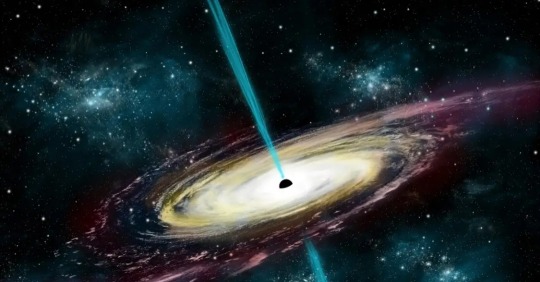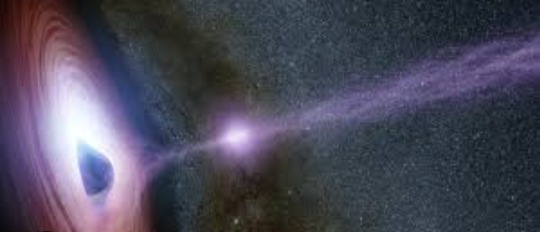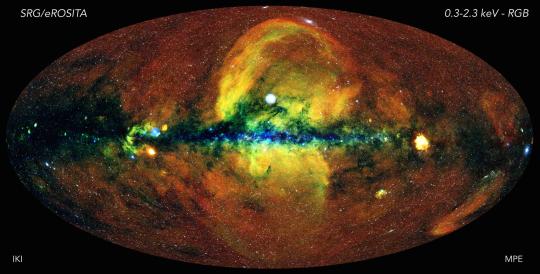#active galactic nuclei
Explore tagged Tumblr posts
Text

An image captured by the Hubble Space Telescope depicts Arp-Madore 2339-661, an object that until not many years ago was considered a pair of interacting galaxies, cataloged as NGC 7733 (bottom right) and NGC 7734 (top left). However, observing the upper arm of NGC 7733, it's possible to see a sort of large knot of a color different from the predominant blue which is actually a dwarf galaxy, now cataloged as NGC 7733N. The consequence is that the interaction taking place is what some call a merging group. Mergers between two galaxies are normal but sometimes there are more galaxies and in this case, there are three of them that show signs of having active galactic nuclei.
#astronomy#galaxies#galaxy merger#Arp-Madore 2339-661#active galactic nuclei#supermassive black holes
5 notes
·
View notes
Note
Uhhh… quasars!
A quasar is just a blazar that hasn't shot its big load yet

#both are active galactic nuclei but the blazar is the one with the 2 giant polar opposite electromagnetic beams shooting out#further than you can even imagine
16 notes
·
View notes
Link
The Space, Astronomy & Science Podcast. SpaceTime Series 27 Episode 26 *The Brightest and Fastest Growing Black Hole Quasar Ever Seen Astronomers have uncovered a cosmic colossus: the most luminous quasar known, powered by a black hole 17 billion times the mass of the Sun and growing at a staggering rate. The quasar J0529-4351, situated over 12 billion light-years away, is a beacon from the early universe, challenging our understanding of black hole formation and growth. *Supernova 1987A's Hidden Heart: The Neutron Star Within NASA's Webb Space Telescope has pierced through the dusty veil of Supernova 1987A, revealing emissions indicative of a neutron star's presence. This discovery resolves a long-standing debate and provides a glimpse into the violent stellar processes that forge these dense remnants. *Surviving the Cosmic Rays: Earth's First Life and the Shield of Manganese How did life's early building blocks endure Earth's intense radiation? New research suggests that cell-like structures with manganese-based antioxidants could have been life's ancient protectors, enabling the survival and evolution of the first organisms in a gamma-ray-blasted world. *Leap Year Explained: Why February Gains an Extra Day As February 29 approaches, we demystify the leap year phenomenon. Learn how this calendrical correction ensures our timekeeping stays in harmony with Earth's orbit, and discover the historical and astronomical significance behind the extra day in February. Join us on SpaceTime as we delve into the depths of black holes, witness the aftermath of stellar explosions, and explore the primordial resilience of life on our planet. Tune in for a journey through the cosmos and the intricacies of our celestial calendar. Listen to SpaceTime on your favorite podcast app with our universal listen link: https://spacetimewithstuartgary.com/listen and access show links via https://linktr.ee/biteszHQ For more SpaceTime and show links: https://linktr.ee/biteszHQ For more space and astronomy podcasts visit our HQ at https://bitesz.com Become a supporter of this podcast: https://www.spreaker.com/podcast/spacetime-with-stuart-gary--2458531/support.
#accretion#active#astronomy#black#disc#european#event#galactic#hole#horizon#learning#machine#nuclei#observatory#quasar#samuel#southern#speeds#superluminal#supermassive
2 notes
·
View notes
Text
Galaxy with ‘Forbidden’ Light

This whirling image features a bright spiral galaxy known as MCG-01-24-014, which is located about 275 million light-years from Earth. In addition to being a well-defined spiral galaxy, MCG-01-24-014 has an extremely energetic core known as an active galactic nucleus (AGN) and is categorized as a Type-2 Seyfert galaxy. Seyfert galaxies, along with quasars, host one of the most common subclasses of AGN. While the precise categorization of AGNs is nuanced, Seyfert galaxies tend to be relatively nearby and their central AGN does not outshine its host, while quasars are very distant AGNs with incredible luminosities that outshine their host galaxies.
There are further subclasses of both Seyfert galaxies and quasars. In the case of Seyfert galaxies, the predominant subcategories are Type-1 and Type-2. Astronomers distinguish them by their spectra, the pattern that results when light is split into its constituent wavelengths. The spectral lines that Type-2 Seyfert galaxies emit are associated with specific ‘forbidden’ emission lines. To understand why emitted light from a galaxy could be forbidden, it helps to understand why spectra exist in the first place. Spectra look the way they do because certain atoms and molecules absorb and emit light at very specific wavelengths. The reason for this is quantum physics: electrons (the tiny particles that orbit the nuclei of atoms and molecules) can only exist at very specific energies, and therefore electrons can only lose or gain very specific amounts of energy. These very specific amounts of energy correspond to the wavelengths of light that are absorbed or emitted.
Forbidden emission lines should not exist according to certain rules of quantum physics. But quantum physics is complex, and some of the rules used to predict it were formulated under laboratory conditions here on Earth. Under those rules, this emission is ‘forbidden’ – so improbable that it’s disregarded. But in space, in the midst of an incredibly energetic galactic core, those assumptions don’t hold anymore, and the ‘forbidden’ light gets a chance to shine out toward us. Text credit: European Space AgencyImage credit: ESA/Hubble & NASA, C. Kilpatrick
#space#nasa#universe#art#astronomy#science#galaxy#moon#stars#cosmos#spacex#scifi#astrophotography#photography#earth#astronaut#love#alien#nature#mars#spaceart#sky#spaceexploration#planets#aliens#spaceship#spacetravel#rocket#digitalart#design
79 notes
·
View notes
Text
Charlene Heisler
Charlene Heisler was born in 1961 in Calgary, Alberta. When Heisler was about to begin her PhD in astronomy, her doctors advised against it. They said that she would only survive a couple of years due to her cystic fibrosis. Yet she not only completed her PhD at Yale, but also became a world-renowned astronomer. Heisler made significant contributions to the understanding of active galaxies, and to why some galaxies, but not others, have broad-line regions. Her final major project was the COLA project, which sought to determine whether there was a link between active galactic nuclei and starburst activity.
Charlene Heisler died in 1999 at the age of 37. The Astronomical Society of Australia gives the Charlene Heisler Prize each year in her honor.
#astronomy#astronomers#stem#women in stem#women scientists#science#scientists#cystic fibrosis#women with disabilities
41 notes
·
View notes
Text
WHAT IS MORE POWERFUL THAN A QUASAR??
Blog#409
Wednesday, June 12th, 2024.
Welcome back,
On July 12th, 2018, researchers announced that they’d caught a single, tiny, high-energy particle called a neutrino that had rained down on Earth from a supermassive black hole some 4 billion light-years away.
Astrophysicists are excited because this is only the third identified cosmic object they’ve managed to collect the elusive particles from — first the Sun, then a supernova that went off in a neighboring galaxy in 1987, and now a blazar.

So, what is a blazar, anyway?
At the center of most galaxies — including our own Milky Way — there’s a gargantuan black hole that can have the mass of millions or even billions of Suns. In some galaxies, this supermassive black hole may collect a swirling disk of gas, dust and stellar debris around it to eat from.
As material in the disk falls toward the black hole, its gravitational energy can be converted to light, making the centers of these galaxies very bright and giving them the name active galactic nuclei (AGN).

Some of these active galactic nuclei also shoot out colossal jets of material that travel close to the speed of light. Scientists call this a quasar.
But when a galaxy happens to be oriented so the jets point toward Earth — and we’re staring right down the barrel of the gun, as it were — it’s called a blazar. It’s the same thing as a quasar, just pointed at a different angle.
Those jets shoot matter at close to the speed of light in our direction and, we now know, produce high-energy neutrinos like the one detected by the IceCube instrument in September 2017.

The first blazar found was originally misidentified as an oddball of a star. In 1929, the German astronomer Cuno Hoffmeister published a catalog of 354 objects he thought were variable stars, or stars that get brighter and fainter over fairly short periods of time. This catalog included an object that was called BL Lacertae, or BL Lac for short, after the constellation it was in — Lacerta, the lizard.
By the late 1960s and 1970s, astronomers began to notice something funny about BL Lac. It did get brighter and fainter, but not in a regular, predictable way, and it seemed to emit a lot of light in the radio wave regime, which was unusual for stars.

Further studies showed that BL Lac was too far away to be a star in the Milky Way galaxy. And in some ways, its behavior looked more like another mysterious object astronomers were finding — called quasars — than it did variable stars.
Eventually, astronomers found that BL Lac was in fact a bright object in the center of a distant galaxy. And they began to find other objects that shared BL Lac’s strange properties, calling them “BL Lac objects.” By 1980, they coined the name blazars, combining “BL Lac objects” with the somewhat similar “quasars.”

Studies in the 1980s and 1990s gave evidence that the bright radio light from blazars came from jets of material moving at relativistic speeds. By the mid-1990s, astronomers determined that blazars, quasars, and some other bright galaxy phenomena they observed were all in the same family of objects: active galactic nuclei.
Originally published on www.astronomy.com
COMING UP!!
(Saturday, June 15th, 2024)
"WHY DO PLANETS ROTATE??"
#astronomy#outer space#alternate universe#astrophysics#universe#spacecraft#white universe#space#parallel universe#astrophotography
75 notes
·
View notes
Link
These gas emissions are believed to fuel the process of star formation in galaxies but are not yet well understood. Astronomers are interested in learning more about them to improve our understanding of what governs galactic evolution.
This is the purpose of the SUper massive Black hole Winds in the x-rAYS (SUBWAYS) project, an international research effort dedicated to studying quasars using the ESA's XMM-Newton space telescope.
The first results of this project were shared by a group of scholars led by the University of Bologna and the National Institute for Astrophysics (INAF) in Italy. In the paper that describes their findings, the team presented X-ray spectroscopic data to characterize the properties of UFOs in 22 luminous galaxies.
Continue Reading
522 notes
·
View notes
Text

Newfound galaxy class may indicate early black hole growth
In December 2022, less than six months after commencing science operations, NASA's James Webb Space Telescope revealed something never seen before: numerous red objects that appear small in the sky, which scientists soon called "little red dots" (LRDs). Though these dots are quite abundant, researchers are perplexed by their nature, the reason for their unique colors, and what they convey about the early universe.
A team of astronomers recently compiled one of the largest samples of LRDs to date, nearly all of which existed during the first 1.5 billion years after the Big Bang. They found that a large fraction of the LRDs in their sample showed signs of containing growing supermassive black holes.
"We're confounded by this new population of objects that Webb has found. We don't see analogs of them at lower redshifts, which is why we haven't seen them prior to Webb," said Dale Kocevski of Colby College in Waterville, Maine, and lead author of the study posted to the arXiv preprint server. "There's a substantial amount of work being done to try to determine the nature of these little red dots and whether their light is dominated by accreting black holes."
A potential peek into early black hole growth
A significant contributing factor to the team's large sample size of LRDs was their use of publicly available Webb data. To start, the team searched for these red sources in the Cosmic Evolution Early Release Science (CEERS) survey before widening their scope to other extragalactic legacy fields, including the JWST Advanced Deep Extragalactic Survey (JADES) and the Next Generation Deep Extragalactic Exploratory Public (NGDEEP) survey.
The methodology used to identify these objects also differed from previous studies, resulting in the census spanning a wide redshift range. The distribution they discovered is intriguing: LRDs emerge in large numbers around 600 million years after the Big Bang and undergo a rapid decline in quantity around 1.5 billion years after the Big Bang.
The team looked toward the Red Unknowns: Bright Infrared Extragalactic Survey (RUBIES) for spectroscopic data on some of the LRDs in their sample. They found that about 70% of the targets showed evidence for gas rapidly orbiting 2 million miles per hour (1,000 kilometers per second)—a sign of an accretion disk around a supermassive black hole. This suggests that many LRDs are accreting black holes, also known as active galactic nuclei (AGN).
"The most exciting thing for me is the redshift distributions. These really red, high-redshift sources basically stop existing at a certain point after the Big Bang," said Steven Finkelstein, a co-author of the study at the University of Texas at Austin. "If they are growing black holes, and we think at least 70% of them are, this hints at an era of obscured black hole growth in the early universe."
Contrary to headlines, cosmology isn't broken
When LRDs were first discovered, some suggested that cosmology was "broken." If all of the light coming from these objects was from stars, it implied that some galaxies had grown so big, so fast, that theories could not account for them.
The team's research supports the argument that much of the light coming from these objects is from accreting black holes and not from stars. Fewer stars means smaller, more lightweight galaxies that can be understood by existing theories.
"This is how you solve the universe-breaking problem," said Anthony Taylor, a co-author of the study at the University of Texas at Austin.
Curiouser and curiouser
There is still a lot up for debate as LRDs seem to evoke even more questions. For example, it is still an open question as to why LRDs do not appear at lower redshifts. One possible answer is inside-out growth: As star formation within a galaxy expands outward from the nucleus, less gas is being deposited by supernovas near the accreting black hole, and it becomes less obscured. In this case, the black hole sheds its gas cocoon, becomes bluer and less red, and loses its LRD status.
Additionally, LRDs are not bright in X-ray light, which contrasts with most black holes at lower redshifts. However, astronomers know that at certain gas densities, X-ray photons can become trapped, reducing the amount of X-ray emission. Therefore, this quality of LRDs could support the theory that these are heavily obscured black holes.
The team is taking multiple approaches to understand the nature of LRDs, including examining the mid-infrared properties of their sample, and looking broadly for accreting black holes to see how many fit LRD criteria. Obtaining deeper spectroscopy and select follow-up observations will also be beneficial for solving this currently "open case" about LRDs.
"There's always two or more potential ways to explain the confounding properties of little red dots," said Kocevski. "It's a continuous exchange between models and observations, finding a balance between what aligns well between the two and what conflicts."
These results were presented in a press conference at the 245th meeting of the American Astronomical Society in National Harbor, Maryland, and have been accepted for publication in The Astrophysical Journal.
IMAGE: A team of astronomers found that these mysterious red objects that appear small on the sky emerge in large numbers around 600 million years after the Big Bang and undergo a rapid decline in quantity around 1.5 billion years after the Big Bang. Spectroscopic data of some of the LRDs in their sample, provided by the Red Unknowns: Bright Infrared Extragalactic Survey (RUBIES), suggests that many are accreting black holes. However, further study of these intriguing objects is required. Credit: NASA, ESA, CSA, STScI, Dale Kocevski (Colby College)
23 notes
·
View notes
Text

The universe as seen with the eROSITA X-ray telescope
As eROSITA scans the sky, the energy of the collected photons is measured with an accuracy ranging from 2% – 6%.
To generate this image, in which the whole sky is projected onto an ellipse (so-called Aitoff projection) with the center of the Milky Way in the middle and the body of our Galaxy running horizontally, photons have been color-coded according to their energy (red for energies 0.3-0.6 keV, green for 0.6-1 keV, blue for 1-2.3 keV).
The red diffuse glow away from the galactic plane is the emission of the hot gas in the vicinity of the Solar System (the Local Bubble). Along the plane itself, dust and gas absorb the lowest energy X-ray photons, so that only high-energy emitting sources can be seen, and their color appears blue in the image.
The hotter gas close to the Galactic center, shown in green and yellow, carries imprinted the history of the most energetic processes in the life of the Milky Way, such as supernova explosions, driving fountains of gas out of the plane, and, possibly, past outburst from the now dormant supermassive black hole in the center of the Milky Way.
Piercing through this turbulent, hot diffuse medium, are hundreds of thousands of X-ray sources, which appear mostly white in the image, and uniformly distributed over the sky. Among them, distant active galactic nuclei are visible as point sources, while clusters of galaxies reveal themselves as extended X-ray nebulosities.
In total, about one million X-ray sources have been detected in this image.
Image credit: Jeremy Sanders, Hermann Brunner & the eSASS team / Max Planck Institute for Extraterrestrial Physics / Eugene Churazov & Marat Gilfanov, IKI.
#art#cosmos#cosmic#universe#blast#wallpaper#photography#x_ray#eROSITA#telescope#x-ray telescope#aitoff projection#space#stars#space wallpaper#universe wallpaper
63 notes
·
View notes
Text


An article to be published in "The Astrophysical Journal" reports the discovery of about 2,500 new candidate active galactic nuclei in dwarf galaxies and about 300 new candidate intermediate-mass black holes. A team of researchers examined observations conducted with the Dark Energy Spectroscopic Instrument (DESI) on the Nicholas U. Mayall 4-meter Telescope in Arizona to find all these possible black holes.
0 notes
Text

The Swirling Center of NGC 4261 - December 5th, 1995.
"What evil lurks in the hearts of galaxies? The above picture by the Hubble Space Telescope of the center of the nearby galaxy NGC 4261 tells us one dramatic tale. Here gas and dust are seen swirling near this elliptical galaxy's center into what is almost certainly a massive black hole. The disk is probably what remains of a smaller galaxy that fell in hundreds of millions of years ago. Collisions like this may be a common way of creating such active galactic nuclei as quasars. Strangely, the center of this fiery whirlpool is offset from the exact center of the galaxy - for a reason that remains an astronomical mystery."
50 notes
·
View notes
Text
wanna go back to the Stone Age and tell someone about active galactic nuclei and watch their head explode
8 notes
·
View notes
Text
2 notes
·
View notes
Link
2 min read Hubble Glimpses a Bright Galaxy Group This new NASA Hubble Space Telescope image shows a tangled group of interacting galaxies called LEDA 60847. NASA/ESA/A. Barth (University of California – Irvine)/M. Koss (Eureka Scientific Inc.)/A. Robinson (Rochester Institute of Technology)/Processing: Gladys Kober (NASA/Catholic University of America) This new NASA Hubble Space Telescope image shows a group of interacting galaxies known as LEDA 60847. LEDA 60847 is classified as an active galactic nuclei, or AGN. An AGN has a supermassive black hole in the galaxy’s central region that is accreting material. The AGN emits radiation across the entire electromagnetic spectrum and shines extremely brightly. By studying powerful AGNs that are relatively nearby, astronomers can better understand how supermassive black holes grow and affect galaxies. Galaxy mergers are relatively common occurrences. Most larger galaxies are the result of smaller galaxies merging. The Milky Way itself contains traces of other galaxies, indicating it is the product of past mergers. Astronomers believe somewhere between 5% and 25% of all galaxies are currently merging. This image of LEDA 60847 combines ultraviolet, visible, and near-infrared data from Hubble. The ability to see across all those wavelengths is one of the things that makes Hubble unique. Different types of light across the electromagnetic spectrum tell astronomers different things about our universe. Ultraviolet light traces the glow of stellar nurseries and is used to identify the hottest stars. Visible light shows us moderate-temperature stars and material, and also how the view would appear to our own eyes. Last but not least, near-infrared light can penetrate cold dust, allowing us to study warm gas and dust, and relatively cool stars. LEARN MORE: Hubble’s Cosmic Collisions Hubble Science: Galaxy Details and Mergers Hubble Science: Tracing the Growth of Galaxies Download this image Media Contact: Claire AndreoliNASA’s Goddard Space Flight Center, Greenbelt, [email protected] Share Details Last Updated Jan 23, 2024 Editor Andrea Gianopoulos Location Goddard Space Flight Center Related Terms Active Galaxies Astrophysics Division Galaxies Goddard Space Flight Center Hubble Space Telescope Missions The Universe Keep Exploring Discover More Topics From NASA Hubble Space Telescope Since its 1990 launch, the Hubble Space Telescope has changed our fundamental understanding of the universe. Galaxies Stories Stars Stories James Webb Space Telescope Webb is the premier observatory of the next decade, serving thousands of astronomers worldwide. It studies every phase in the…
59 notes
·
View notes
Text
Spinning Spiral ESO 420-G013

Looking like a baseball lobbed into the depths of the universe, ESO 420-G013 is a face-on spiral galaxy and a Seyfert galaxy. Dark lanes of dust are stitched across the background glow of the galaxy’s many stars.
About 10 percent of all the galaxies in the universe are thought to be Seyfert galaxies. They are typically spiral galaxies and have very bright nuclei, the result of supermassive black holes at their centers accreting material that releases vast amounts of radiation. The cores of these “active galaxies” are brightest when observing light outside the visible spectrum. Often galaxies with these kinds of active galactic nuclei are so bright that the host galaxy itself cannot be seen, washed out by the glow of its nuclei, but Seyfert galaxies are distinctive because the galaxy itself is also visible. In the case of ESO 420-G013, we can enjoy the galaxy’s almost perfectly round disk, brighter core, and whirled filaments of dark dust.
NASA’s Hubble Space Telescope observed ESO 420-G013 as part of a study of Luminous Infrared Galaxies, or LIRGs, which are known to be extremely bright in the infrared part of the spectrum. Galactic interactions trigger new regions of star formation in LIRGs, causing them to be highly luminous in infrared light.
Credit: NASA/ESA/A. Evans (University of Virginia)/Processing: Gladys Kober (NASA/Catholic University of America)
Join Community !
#space#nasa#universe#art#astronomy#science#galaxy#moon#stars#cosmos#spacex#scifi#astrophotography#photography#earth#astronaut#love#alien#nature#mars#spaceart#sky#spaceexploration#planets#aliens#spaceship#spacetravel#rocket#digitalart#design
34 notes
·
View notes
Text

@superusrblog 👈🏻 follow
Quasars are extremely luminous active galactic nuclei powered by supermassive black holes. They are among the most distant objects observed in the universe and can outshine entire galaxies.
#physics#astronomy#writers on tumblr#space#space science#trending#space exploration#fun facts#astrology#galaxy#galaxies#astrography#our universe#unknown#uncommon facts
5 notes
·
View notes